One of the now-normal occurrences of life in this Age of the Corona Virus, at least for those of us who watch the nightly news, is our newfound entry into the personal spaces of the talking heads who must broadcast remotely from their homes. These intrusions into their private lives, voluntarily accepted as they are by the participants, have occasioned much comment, some of it snarky, on sites such as Room Rater. A typical rating there: “Cozy room, warm colors, animal art, but could use an updated paint job on the green wall. 6/10” for NBC correspondent Cynthia McFadden.
My wife, Roberta, early on noticed the artworks that often appear behind the participants and suggested that I write a blog about them. Accordingly, I sent emails to many participants, asking them to tell me the names of the artists whose works are on their walls. “I don’t know yet what I’m going to write,” I told them. “I certainly have no intention of criticizing anyone’s taste. But these little windows into what we hang on our walls provide a springboard for a discussion of the art we choose and how we choose it.”
I received a fair number of responses to my queries. Philip Rucker of The Washington Post has a landscape by Robert Andriulli which he bought at a gallery in Baltimore. Peter Berns, CEO of The Arc, an organization which works on behalf of people with intellectual and developmental disabilities, has an abstract painting by Edna Kurtz Emmet, an Israeli artist now living in Baltimore. Two responders have paintings by their parents: A.B. Stoddard of RealClearPolitics has a beach scene by her father, Brandon Stoddard, and Adam Goldman of The New York Times has a painting by his mother, Elizabeth Goldman. (Had I been on television, viewers would have been able to see at least one of three paintings by my mother that hang on my walls.)


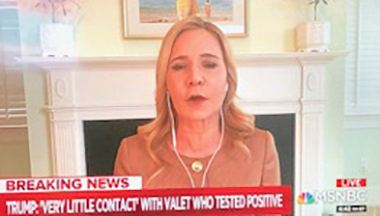



Friendship often played a part in the acquisition of the art. Breea Clark, mayor of Norman, OK, has a painting of a sunflower, the state flower of her native Kansas, done by friend and city councilmember Alexandra Scott. Singer-songwriter Jeremy Parsons has an oil by his friend P.J. Schenkel, a multimedia artist who defies categorization.
Sometimes I didn’t need to send a query. I happen to know that New York Times columnist Michelle Goldberg is married to the great-grandson of sculptor William Zorach. That’s his bronze at the right on the shelf behind her. In the case of Connecticut congresswoman Jahanna Hayes, the artwork, though only partially visible, is obviously a reproduction of Norman Rockwell’s famous painting The Problem We All Live With, showing Ruby Bridges, an African-American schoolgirl, being escorted to school by federal marshals. I didn’t hear back from Deirdre Bosa of CNBC Business News, but I’d be willing to bet money that the paintings at the left and center behind her are by contemporary Western artist Michael Coleman.
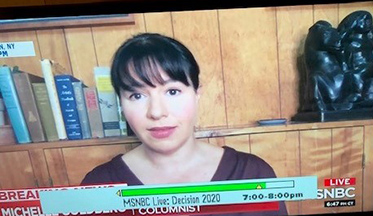

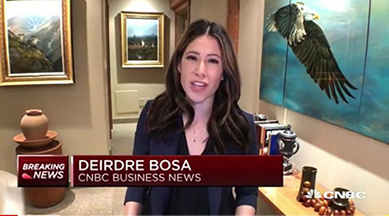


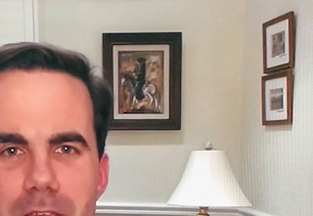
Dr. John Brownstein, an epidemiologist at Harvard Medical School, has a landscape with egrets by Stan Moeller, an artist who lives in Maine. Dr. William Schaffner, a professor of preventative medicine of Vanderbilt University School of Medicine, has an abstract oil by Nashville artist Edie Maney.
Robert Costa of The Washington Post has a painting of the 16th century Jesuit missionary Padre Kino by Ettore “Ted” DeGrazia. Nicholas Kristof of The New York Times has Japanese painted screen from the 1920’s that he bought in Kyoto in 1997 while working as Tokyo bureau chief.
There were some inquiries to celebrities that went unanswered, which I expected, but whose answers I would have liked to know. Having met Oprah Winfrey at several art fairs, I can confirm that she’s been a knowledgeable and serious collector of art for many years, and I wanted the name of the artist of the painting in her photo. Likewise, the rapper and now media mogul 50 Cent has a striking painting in the background.

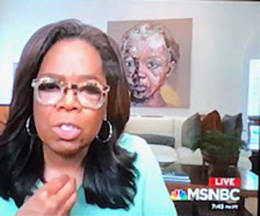

The works on display were acquired in a number of ways and using different criteria. Some works were inherited, some were gifts, some have associations with places where their owners lived in the past, and some no doubt were acquired with concern for a place on the wall that needed an artwork of a certain size and color to blend harmoniously with the setting. None of those reasons for acquisition was wrong. Museums collect with an eye to art historical movements, but in decorating our caves (and yes, the decorative impulse has always had a significant role in the making of art), we need consider nothing but pleasure, either visual or associative.
Henri Matisse once asserted, “What I dream of is an art of balance, of purity and serenity, devoid of troubling or depressing subject-matter, an art which could be for every mental worker, for the businessman as well as the man of letters, for example, a soothing, calming influence on the mind, something like a good armchair which provides relaxation from physical fatigue.” Matisse’s aspirations for such an art have gotten him lambasted ever since by critics of an intellectually rigorous bent, but there is an undeniable truth to it. There is no wrong here. The only caveat I would make here is that when a painting becomes “part of the furniture,” when you don’t really see it anymore, you should consider changing the painting, either by swapping it for another work currently hanging elsewhere in your home or by getting a new piece to replace it.
But there I go with “shoulds.” In this area, the only “should” is pleasure. I wish you nothing but pleasure in your art as you shelter in place. Enjoy. And wash your hands.

